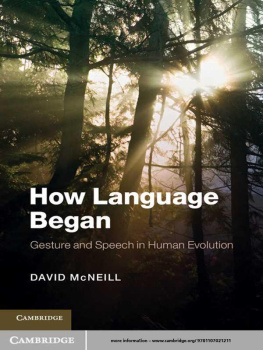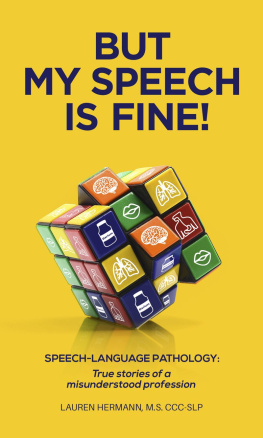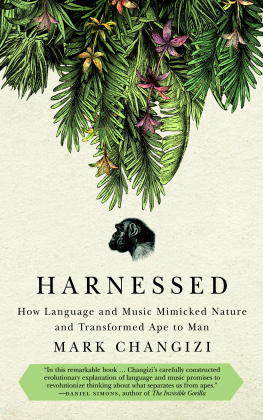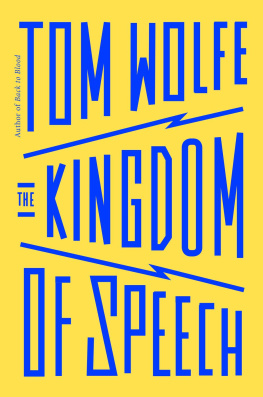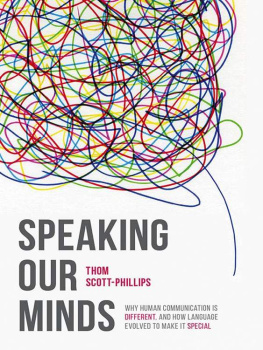How Language Began
Human language is not the same as human speech. We use gestures and signs to communicate alongside, or instead of, speaking. Yet gestures and speech are processed in the same areas of the human brain, and the study of how both have evolved is central to research on the origins of human communication. Written by one of the pioneers of the field, this is the first book to explain how speech and gesture evolved together into a system that all humans possess. Nearly all theorizing about the origins of language either ignores gesture, views it as an add-on, or supposes that language began in gesture and was later replaced by speech. David McNeill challenges the popular gesture-first theory that language first emerged in a gesture-only form, and proposes a ground-breaking theory of the evolution of language which explains how speech and gesture became unified.
David McNeill is Professor Emeritus in the Departments of Psychology and Linguistics at the University of Chicago. His publications include Hand and Mind (1992), Gesture and Thought (2005), and Language and Gesture (Cambridge, 2000).
Approaches to the Evolution of Language
The evolution of human language is a rapidly growing area of study and research, undertaken from a wide range of perspectives. This new series provides a forum for the very best contributions to this fascinating subject. Taking an interdisciplinary approach, the series as a whole encourages a productive dialogue between those working in linguistics, biology, psychology, anthropology and cognitive science.
Published titles
Language Evolution and Syntactic Theory Anna R. Kinsella
The Evolution of Human Language: Biolinguistic Perspectives Richard K. Larson , Viviane Deprz and Hiroko Yamakido
How Language Began: Gesture and Speech in Human Evolution David McNeill
CAMBRIDGE UNIVERSITY PRESS
Cambridge, New York, Melbourne, Madrid, Cape Town, Singapore, So Paulo, Delhi, Mexico City
Cambridge University Press
The Edinburgh Building, Cambridge CB2 8RU, UK
Published in the United States of America by Cambridge University Press, New York
www.cambridge.org
Information on this title: www.cambridge.org/9781107605497
David McNeill 2012
This publication is in copyright. Subject to statutory exception and to the provisions of relevant collective licensing agreements, no reproduction of any part may take place without the written permission of Cambridge University Press.
First published 2012
Printed in the United Kingdom at the University Press, Cambridge
A catalog record for this publication is available from the British Library
Library of Congress Cataloging in Publication data
McNeill, David.
How language began : gesture and speech in human evolution / David McNeill.
pages ; cm
Includes bibliographical references and index.
ISBN 978-1-107-02121-1 (hardback : alkaline paper)
1. Language and languages Origin.2. Speech and gesture.I. Title.
P116.M4552012
401 dc232012021835
ISBN 978-1-107-02121-1 Hardback
ISBN 978-1-107-60549-7 Paperback
Cambridge University Press has no responsibility for the persistence or accuracy of URLs for external or third-party internet websites referred to in this publication, and does not guarantee that any content on such websites is, or will remain, accurate or appropriate.
Preface Out on a limb
This is my third book to focus on the nexus of gesture and language. Together, the three amount to a kind of unintended trilogy, what has turned out to be a sustained examination and ultimate explanation of a certain phenomenon. The first, Hand and Mind (1992), introduced what was then a newly discovered world of gesture, not the stand-alones (known as emblems) that have been acknowledged for millennia, but those overlooked but omnipresent gestures that wed themselves to speech itself. The second, Gesture and Thought (2005), developed an explanation of this wedding, the growth point. Now I tackle the origin of the growth point in evolution. By this third volume I am aware of having run far out on a limb. Out on a limb because in crafting the book I have followed a line of argument to its logical limit, or as close to a limit as I can get. The line is that language is more than the lexicosyntactic forms that one sees in written texts and the analyses of linguistics. It is also imagery. This imagery is in gesture, and is inseparable from language. The hypothesis of a growth point encompasses this idea. Taking seriously that language includes gesture as an integral component changes the look of everything. We see language in a new way, as a dynamic language-as-action-and-being phenomenon, not replacing but joining the traditional static (synchronic) language-as-object conception that has guided linguistics for more than a century.
One idea is more than one note, and in pursuing it I have discovered that it touches a wide range of other topics in language, children's development, brain, mind, and society. In this way, a great breadth of phenomena is linked. I cover, besides gesture and its binding power with speech, a specific mechanism for the origin of language, and the scenarios in which it could have arisen; an alternative, the gesture-first hypothesis, which fails both by predicting what did not evolve and not predicting what did evolve; the equiprimordiality of speech and gesture instead; a thoughtlanguagehand brain link present in all humans but revealed directly in deafferentation cases where gestures occur normally but practical actions are impossible; phylogenetic echoes in ontogenesis of two language origins, one of which is extinct (which extinction is also echoed in ontogenesis); new forms of action of the hands and vocal tract orchestrated by significances other than the actions themselves; the origin of syntax, while biological, to make these new actions shareable and portable in encounters with others in socio-culturally maintained templates (constructions); psychological sources of linguistic diversity; parallels and non-parallels to human language in chimpanzee and other primates; the remarkable, still-emerging discoveries in comparative genetics of the two or three kinds of humans known to have existed and how they may have differed in linguistic capacities; how consciousness and memory were reshaped by the origin of language; gestures during musical performances and the possibility of gestures hidden in written prose on the page; the loss of language at points of vulnerability left over from the origin; and the unlikelihood of language evolving in any species that lacks hands.
Acknowledgments
For comments on the manuscript, I am grateful to Carolin Kirchhof, Liesbet Quaeghebeur, Kazuki Sekine, Randall L. B. McNeill, Frank Bechter, Jana Bressem, and above all Elena Levy, with whom years ago I started the serious study of speech and gesture and who has read and commented on the manuscript more than once. I have done my best to incorporate everything these responsive fellow gesture-world inhabitants have suggested.
My colleague, Susan Duncan, has played a huge role in the development of the growth point concept, and her many contributions are recognized throughout the text.

